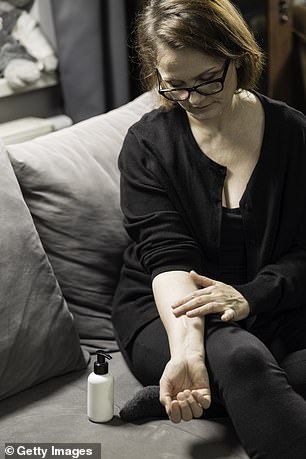Could a new insulin spray on your arm end the need for a diabetes shot? Hope in sight for millions currently injecting up to three times a day
- Test with spray – in handy pocket size – starts in Norway
- You just need to inject insulin into the inside of the arm
An insulin body spray could eliminate the need for shots for diabetes.
A trial with patients will soon start in Norway to see whether the spray can control blood sugar levels as effectively as the injections.
Patients inject the insulin directly onto the inside of their forearm, where the skin is thinner, making absorption easier. Within minutes it is absorbed into the bloodstream, where it helps cells clear sugar from the blood to use as fuel for energy.
The spray – which comes in a handy pocket-sized sachet – could provide an alternative for those who currently need to inject insulin three or more times a day in some cases. Diabetes occurs when the pancreas – a pear-shaped organ located behind the stomach – stops producing insulin completely, or its production drops sharply, or cells become resistant to the insulin the body produces.
According to Diabetes UK, one in three patients regularly miss their insulin injection because they are afraid of needles
Without the right amount of insulin, blood sugar levels can rise, causing irreversible damage to the kidneys, eyes, nerves and blood vessels.
More than 90 percent of diabetes cases are type 2, which is associated with obesity and a sedentary lifestyle (although it can also run in families).
In many cases, type 2 can be treated well with lifestyle changes and daily tablets to control blood sugar levels; only one in four patients ultimately needs daily insulin injections.
Type 1 diabetes, meanwhile, is caused when the body’s immune system mistakenly attacks the pancreas, causing it to stop making insulin. This means that patients are dependent on insulin injections for the rest of their lives.
But the daily burden of needles can take its toll.
According to Diabetes UK, one in three patients regularly miss their insulin jab because they are afraid of needles or don’t want to attract attention by injecting in public.
Missing regular shots increases the risk of a rise in blood sugar levels and long-term complications such as heart disease, blindness and lower limb amputation due to the effects of high blood sugar on the circulatory system.
Scientists have developed other methods of delivering insulin.
One is an insulin pump, in which the hormone is administered through a tube in the abdomen via a computer-controlled pump worn on the waistband. But the pumps can cost up to £3,000 and are rarely issued by the NHS.

The spray contains insulin and propylene carbonate, a chemical commonly used in cosmetic skin creams
Other researchers are working on skin patches full of microneedles that puncture holes in the skin to allow insulin to pass through.
The latest approach is even less invasive. The spray contains insulin and propylene carbonate, a chemical often used in cosmetic skin creams to help penetrate the outer layers of the skin.
In this case, the hope is that the chemical – which is attached to insulin in the syringe droplets – will help the hormone seep into the small blood vessels that lie beneath the skin’s surface, where the hormone is then absorbed into the bloodstream.
InsuLife, the Norwegian company developing the body spray, is setting up a trial involving 12 patients with type 1 diabetes to see how different doses of the spray compare to injected insulin in controlling blood sugar levels. It is used just before a meal, just like injected insulin.
The clinical trial was set up after a study of five people showed the spray reduced blood sugar levels by about 20 percent after a meal.
Dr. Hood Thabit, a diabetologist at Manchester Royal Infirmary, said it is not yet clear how safe or effective the insulin spray will be, nor how much users will need to apply to get the desired effect on blood sugar levels.
But he added: ‘If it is safe and effective, it could be an important step forward for those suffering from needle phobia.’
